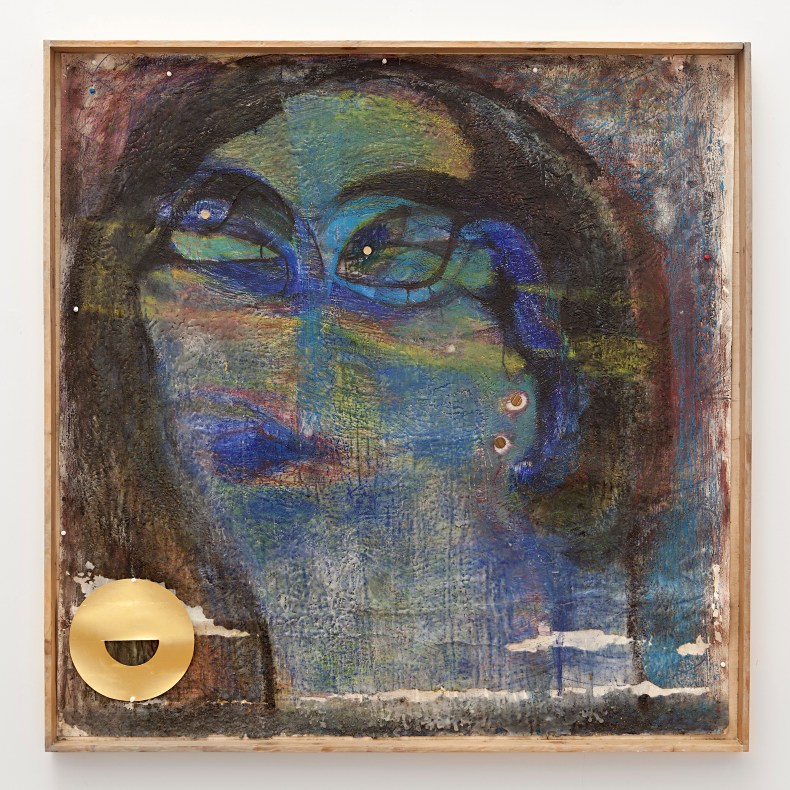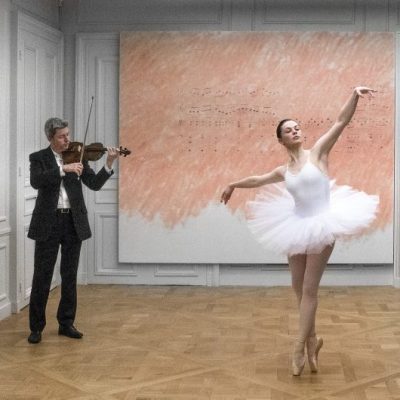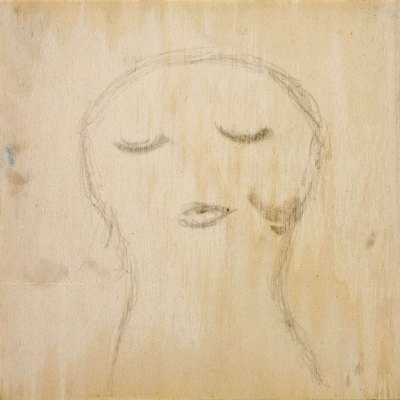To walk into the Met Breuer’s Marisa Merz (b. 1926) retrospective is to find oneself in a hanging garden of bulging sheet metal. Suspended from the ceiling are several large mobiles, all curves and twists and layers, which seem to evoke both industrial piping and ribboned gowns, human entrails and water slides. Visitors pass under what looks like a shredded metal wendy house, with the floor and two walls missing. These are parts of the 1960s series Living Sculpture, which is among the earliest extant works by Merz. Several of the pieces do resemble parts of some large organism, but the title seems still more apt in light of the photographs also shown here of them dangling and spreading through the artist’s house in Turin. These pictures emphasise the work’s ever so slightly threatening charm – installed there in a home, sculpture that demands to be lived with, that refuses to know its place.
Marisa Merz, the only woman to be counted as a practitioner of Arte Povera, is still rather less known than many of the others, including her husband Mario Merz, whose work she was also closely involved with. Yet hers seems to have been not quite – or not only – the usual story of critical neglect. It’s not easy to establish a detailed timeline for either the life or the work. We know where Merz was born (in Turin), when she married and had her daughter Beatrice (1960, in Switzerland), and when the mature phase of her artistic work (which is all we get to see) and its reception began. Other than that, our sense of her first 40 years is hazy, though at some point she seems to have served as a model for the figurative painter Felice Casorati (1883–1963). Merz has generally been reluctant to title or date her works, and has often repurposed individual pieces as part of later installations, so that, despite several shifts in her focus over the decades, any linear account of her development as an artist may be a little misleading.
Untitled (1984), Marisa Merz. Private collection; photo: Andrea Rossetti; courtesy Galleria Monica de Cardenas

The Met Breuer show, which will travel to the Hammer Museum in Los Angeles (4 June–20 August), is on only one floor, but presents a broad range of work. Alongside the larger metal structures (and a big wooden swing made for Beatrice), Merz had begun in the mid 1960s to fashion objects out of copper wire or nylon thread. Best known are perhaps the little shoes (scarpette), which she was sometimes photographed wearing, but there are all sorts of other pieces, including snail-like coils, arrangements of knitting needles partially encased in tight rings of coloured mesh (square or triangular or even spelling out her daughter’s nickname, Bea), a musical stave made of pinned-up wires that takes up half a wall, with small note-like squares of knitted copper scattered across it. Sometimes the woven sheets of copper are pinned in layers to a piece of wooden furniture; one expanse begins flat on a wall and then tears away, its lower section stretching out into the third dimension.
There are an enormous number of clay heads from the mid 1970s onwards, decorated with bright paint and the odd flash of gold leaf, often tipping their faces skywards, their features softly distorted as if emerging out of the material or melting back into it; some of them sit in pairs on tall iron tripods, or appear in larger groups, including on a bed of wax poured out in a big flat square on the floor. Faces (usually angelic-looking women, though also, in one case, a glorious group of horses) appear again and again in drawings, paintings and mixed-media pieces. Some of these in both colour and line combine references to the religious iconography of Italian painting from the Renaissance and earlier, and to the Futurists – though earthier than the former and far gentler, more humane, than the latter.
Most of the pieces elude any single reading, but they all have a playful, even joyous quality. Among several delightfully surreal touches is one of two small fountains on display here: a white paraffin violin lying prone in a shallow lead basin, spurting a bubble of water up towards a tiny ball suspended on a vertical wire just above it. Something has gone slightly awry with it the day I visit: as one member of staff pours more water in from plastic bottles and tests the mechanism with a finger, another tells me that the fountain is ‘meant to sound like violin and cello but it’s not making the sound’. Silenced, the piece retains an eerie tranquility.
Untitled (n.d.), Marisa Merz. Marisa Merz photo: Renata Ghiazzi; courtesy Archivio Merz; © courtesy of the artist and Fondazione Merz

What appear to be Merz’s most recent works – paintings of large saintlike female figures in rich golds and reds and blues – seem a little less subtle than the earlier pieces. Yet from the 1960s work onwards, some sly, whimsical jokes emerge about the feminine, the maternal, and the domestic. In the case of the exquisite shoes that could almost be instruments of torture and the copper wires splaying out to hold down a miniature chair, the use of humble materials and the blurring of lines between gallery art and everyday experience, both characteristic of Arte Povera more broadly, have a slightly different, sharper valence. Delicate, pretty images of female martyrdom appear frequently, whether a Madonna-like woman with metallic curls and a sliver of tape for a mouth, or a newspaper cutting of Falconetti as Dreyer’s Joan of Arc. They find echoes in the many tilted clay heads that seem either trapped and earthbound or ecstatically drawn upward. There’s even a tall cylindrical metal cage with clumps of long hemp tresses knotted at the top and trailing down all around it, as if Rapunzel has dematerialised into her prison.
Merz is in no way a polemicist, but it’s possible to find implied here some bracing questions about what kinds of work (produced in what kinds of conditions) are accorded value.
‘Marisa Merz: The Sky is a Great Space’ is at the Met Breuer, New York, from 24 January–7 May’.
From the March issue of Apollo. Preview and subscribe here.



